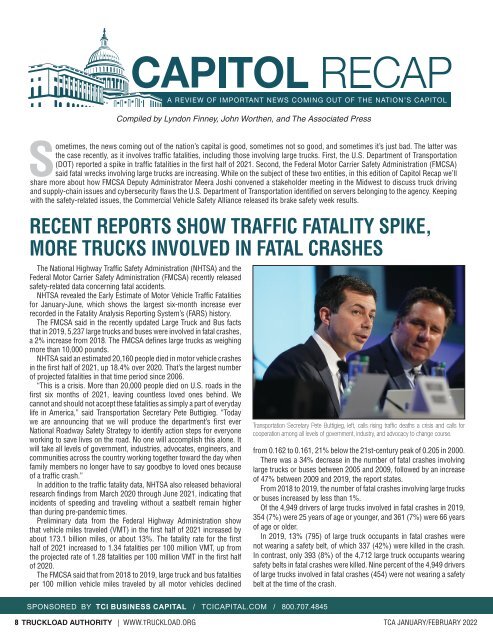Create successful ePaper yourself
Turn your PDF publications into a flip-book with our unique Google optimized e-Paper software.
Compiled by Lyndon Finney, John Worthen, and The Associated Press<br />
Sometimes, the news coming out of the nation’s capital is good, sometimes not so good, and sometimes it’s just bad. The latter was<br />
the case recently, as it involves traffic fatalities, including those involving large trucks. First, the U.S. Department of Transportation<br />
(DOT) reported a spike in traffic fatalities in the first half of 2021. Second, the Federal Motor Carrier Safety Administration (FMCSA)<br />
said fatal wrecks involving large trucks are increasing. While on the subject of these two entities, in this edition of Capitol Recap we’ll<br />
share more about how FMCSA Deputy Administrator Meera Joshi convened a stakeholder meeting in the Midwest to discuss truck driving<br />
and supply-chain issues and cybersecurity flaws the U.S. Department of Transportation identified on servers belonging to the agency. Keeping<br />
with the safety-related issues, the Commercial Vehicle Safety Alliance released its brake safety week results.<br />
RECENT REPORTS SHOW TRAFFIC FATALITY SPIKE,<br />
MORE TRUCKS INVOLVED IN FATAL CRASHES<br />
The National Highway Traffic Safety Administration (NHTSA) and the<br />
Federal Motor Carrier Safety Administration (FMCSA) recently released<br />
safety-related data concerning fatal accidents.<br />
NHTSA revealed the Early Estimate of Motor Vehicle Traffic Fatalities<br />
for January-June, which shows the largest six-month increase ever<br />
recorded in the Fatality Analysis Reporting System’s (FARS) history.<br />
The FMCSA said in the recently updated Large Truck and Bus facts<br />
that in 2019, 5,237 large trucks and buses were involved in fatal crashes,<br />
a 2% increase from 2018. The FMCSA defines large trucks as weighing<br />
more than 10,000 pounds.<br />
NHTSA said an estimated 20,160 people died in motor vehicle crashes<br />
in the first half of 2021, up 18.4% over 2020. That’s the largest number<br />
of projected fatalities in that time period since 2006.<br />
“This is a crisis. More than 20,000 people died on U.S. roads in the<br />
first six months of 2021, leaving countless loved ones behind. We<br />
cannot and should not accept these fatalities as simply a part of everyday<br />
life in America,” said Transportation Secretary Pete Buttigieg. “Today<br />
we are announcing that we will produce the department’s first ever<br />
National Roadway Safety Strategy to identify action steps for everyone<br />
working to save lives on the road. No one will accomplish this alone. It<br />
will take all levels of government, industries, advocates, engineers, and<br />
communities across the country working together toward the day when<br />
family members no longer have to say goodbye to loved ones because<br />
of a traffic crash.”<br />
In addition to the traffic fatality data, NHTSA also released behavioral<br />
research findings from March 2020 through June 2021, indicating that<br />
incidents of speeding and traveling without a seatbelt remain higher<br />
than during pre-pandemic times.<br />
Preliminary data from the Federal Highway Administration show<br />
that vehicle miles traveled (VMT) in the first half of 2021 increased by<br />
about 173.1 billion miles, or about 13%. The fatality rate for the first<br />
half of 2021 increased to 1.34 fatalities per 100 million VMT, up from<br />
the projected rate of 1.28 fatalities per 100 million VMT in the first half<br />
of 2020.<br />
The FMCSA said that from 2018 to 2019, large truck and bus fatalities<br />
per 100 million vehicle miles traveled by all motor vehicles declined<br />
Transportation Secretary Pete Buttigieg, left, calls rising traffic deaths a crisis and calls for<br />
cooperation among all levels of government, industry, and advocacy to change course.<br />
from 0.162 to 0.161, 21% below the 21st-century peak of 0.205 in 2000.<br />
There was a 34% decrease in the number of fatal crashes involving<br />
large trucks or buses between 2005 and 2009, followed by an increase<br />
of 47% between 2009 and 2019, the report states.<br />
From 2018 to 2019, the number of fatal crashes involving large trucks<br />
or buses increased by less than 1%.<br />
Of the 4,949 drivers of large trucks involved in fatal crashes in 2019,<br />
354 (7%) were 25 years of age or younger, and 361 (7%) were 66 years<br />
of age or older.<br />
In 2019, 13% (795) of large truck occupants in fatal crashes were<br />
not wearing a safety belt, of which 337 (42%) were killed in the crash.<br />
In contrast, only 393 (8%) of the 4,712 large truck occupants wearing<br />
safety belts in fatal crashes were killed. Nine percent of the 4,949 drivers<br />
of large trucks involved in fatal crashes (454) were not wearing a safety<br />
belt at the time of the crash.<br />
SPONSORED BY TCI BUSINESS CAPITAL / TCICAPITAL.COM / 800.707.4845<br />
8 TRUCKLOAD AUTHORITY | WWW.TRUCKLOAD.ORG TCA JANUARY/FEBRUARY 2022

















